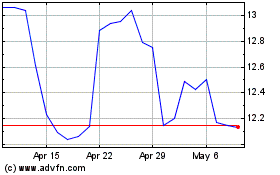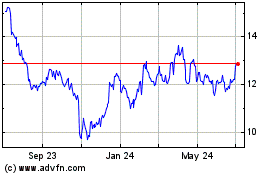By Santanu Choudhury
India's largest car maker, Maruti Suzuki India Ltd., is
releasing a new crossover vehicle this month with a sales flourish
uncommon for a mass-market car brand: white-glove treatment.
The company's new S-Cross will have its own high-tech showroom
that uses Apple Inc. displays to tout vehicle features and complete
a paperless sale. The sales force was recruited from the hotel,
airline and financial services industries--and walk prospects
through the benefits of ownership.
Maruti is new to small crossovers that are growing in popularity
thanks to new products by global players including Ford Motor Co.
and Renault SA. Hyundai Motor Co., No.2 in India's car market, put
a similarly priced small crossover on sale in July.
The move to small crossovers, which carry prices of between
675,000 rupees ($10,359) and 1.37 million rupees, is a bold move
upmarket by Maruti and to a lesser extent by Hyundai. Long the
dominant players in the country's small-car market, the two auto
makers are pushing into premium brand territory.
Maruti's previous attempts to sell higher-end and more
profitable cars such as the Kizashi sedan and the Grand Vitara
sport-utility vehicle in India haven't been successful. Hyundai has
successfully sold its larger Sonata sedan and Santa Fe SUV.
India, the world's sixth-largest passenger vehicle market, is
forecast to grow to No.3 by 2020, behind China and the U.S.
Crossovers were growing at a compound annual rate of 25% since 2011
in India, but that has temporarily cooled amid a drought of new
entries. The two top sellers here hope to revive the sharp
gains.
Crossovers, car-based vehicles designed to look like SUVs, are
quickly growing in many global markets as customers opt for more
interior room and higher ground clearance. In India, only about 4%
of sales come from small crossovers, said Rakesh Srivastava,
Hyundai's sales chief in India.
Current sales numbers suggest Hyundai and Maruti are still in
the sweet spot. Nearly three quarters of the more than 2.6 million
vehicles sold in the last fiscal year comprised passenger cars, and
nearly all of those cars were mostly small hatchbacks made by
Maruti, Hyundai and local rival Tata Motors Ltd.
The biggest players, however, are looking to new product
categories with an eye on boosting profits and staying relevant.
The introduction of such models at Hyundai and Maruti's vast dealer
networks could reignite growth, Mr. Srivastava said.
"The segment will see a lot of excitement and it will not only
bring volumes to Hyundai, but also will grow the industry." Hyundai
said it received about 33,000 orders for the SUV within 29 days of
its introduction which is equivalent to about three times the
entire monthly sales for small crossovers.
Sumit Sawhney, chief executive and managing director for Renault
in India, said: "If more entrants come, then we will see more sedan
buyers again coming into this segment."
Maruti, however, thinks it and Hyundai can disrupt their rivals
recent advances. "None of the existing players will find it as easy
to sell as have been the situation in the past because with Hyundai
and us coming with SUVs, there will be more choices available to
customers," R. C. Bhargava, Maruti's chairman, said in an
interview. S-Cross will be followed with a new sport-utility
vehicle next year, he said.
In addition to an upgraded showroom for buyers of more expensive
cars, Maruti plans to offer home pickups of cars that need service
and to provide an app that informs buyers of their vehicle's
performance. If the customer wants, dealers also will handle
servicing of the car at the customer's home.
Rivals won't stand still. Ford, selling its popular EcoSport,
Volkswagen AG and General Motors Co. all have more crossovers in
the pipeline. Mahindra & Mahindra Ltd., an Indian company known
for its SUVs, is rushing to introduce smaller utilities as
well.
"We estimate 14 new nameplates will be introduced in the market
by 2018 with Maruti Suzuki, Hyundai, and Mahindra emerging as big
winners," Anil Sharma, an analyst at IHS Automotive in India,
said.
Rising disposable incomes in the world's fastest growing major
economy is a significant driver behind crossover demand. Utilities
are also considered as safer and are also becoming the preferred
choice for many as they tackle potholed roads in most parts of
India.
Kanav Arora, a management student in New Delhi, said he decided
to upgrade himself from Hyundai's i20 hatchback to the Creta
because he finds SUVs more spacious and comfortable especially over
rough roads. The comparatively higher ground clearance of a SUV
over sedans also helped convince him to make the leap, he said.
Write to Santanu Choudhury at santanu.choudhury@wsj.com
(END) Dow Jones Newswires
August 18, 2015 14:46 ET (18:46 GMT)
Copyright (c) 2015 Dow Jones & Company, Inc.
Ford Motor (NYSE:F)
Historical Stock Chart
From Mar 2024 to Apr 2024

Ford Motor (NYSE:F)
Historical Stock Chart
From Apr 2023 to Apr 2024
